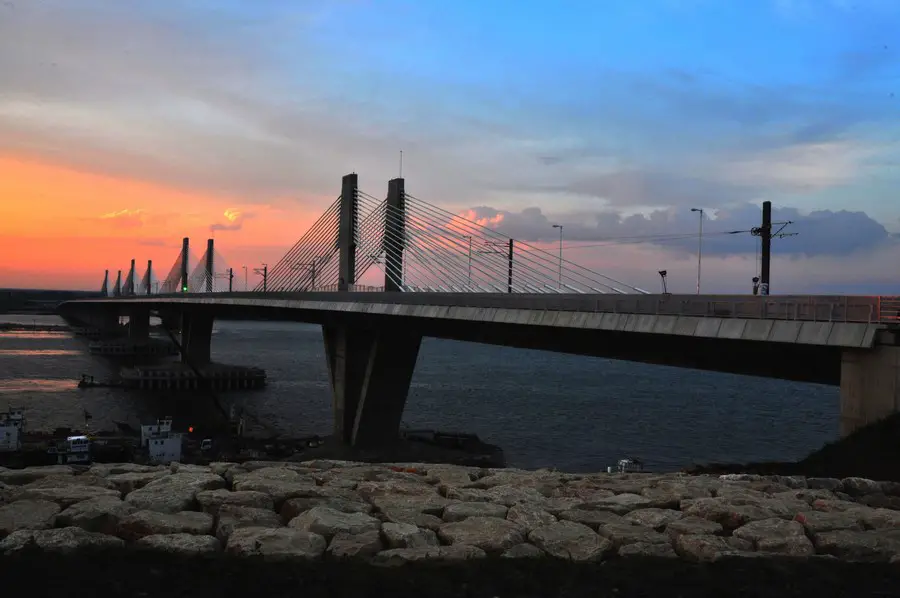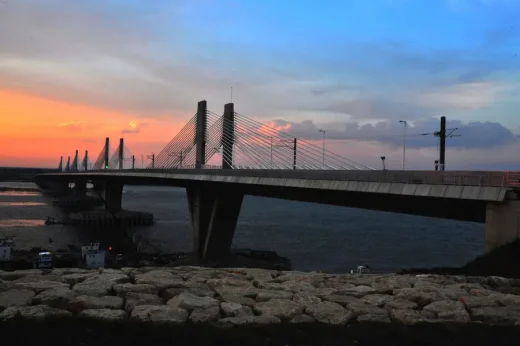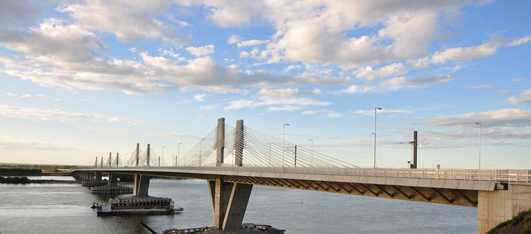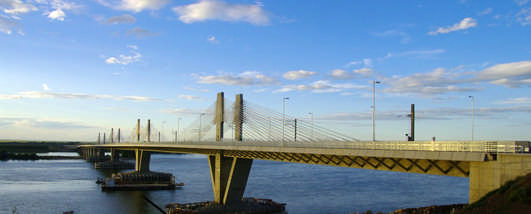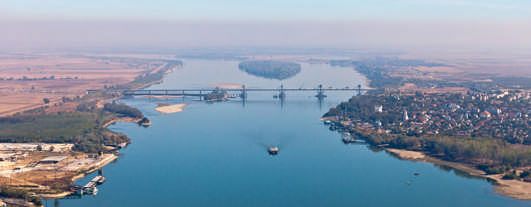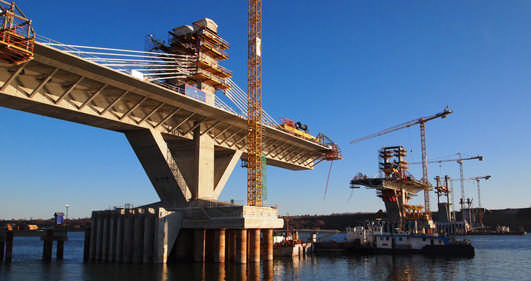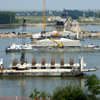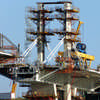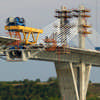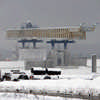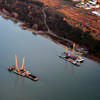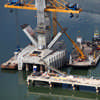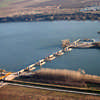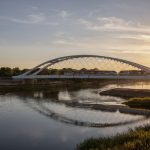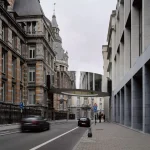New Danube Bridge, Pan-European Corridor IV, Bulgaria and Romania river crossing architecture
Vidin-Calafat Bridge : Bulgaria / Romania
Vidin-Calafat Crossing, Southeastern Europe, by FCC in Bulgaria and Romania
Location: border of Bulgaria & Romania
FCC inaugurates Danube Bridge 2 linking Bulgaria and Romania
• The bridge, which took six years to build, connects Vidin (Bulgaria) and Calafat (Romania)
• This project represents an investment of 275 million euro – partially funded by the European Union
17 Jun 2013
New Danube Bridge
London/Vidin (Bulgaria), 14 June 2013. FCC, the global infrastructure company, has opened to traffic the Vidin-Calafat bridge, linking Bulgaria and Romania that reflects notable progress in connecting the two countries. This bridge, which took six years to build, represents an investment of 275 million euro and was financed in part by the European Union. The Bulgarian Ministry of Transport, Information Technology and Communications promoted the project.
The bridge, which is 1.9 kilometres long, is unique in that it allows for both road and rail traffic, comprising a four-lane motorway, a bike path, two pedestrian walkways and central railway tracks.
FCC also built the railway station accesses, which include a new goods station, the refurbishment of an existing passenger station and 17 kilometres of new railway track. According to both governments, the bridge will be used by more than 100,000 vehicles each year.
It will be managed by a Bulgarian-Romanian joint venture. This transport link will channel all goods and passenger traffic between southern Europe (Greece, Macedonia and Turkey) and the north (Germany, Poland, Czech Republic, Slovakia and Hungary) without passing through non-EU countries.
The bridge also reduces travel time between the two countries. Previously, Calafat and Vidin were only connected by a ferry, which did not run until it was fully loaded with trucks. Moreover, the journey and customs procedures lasted up to three hours; with the new bridge, the travel time will be less than 15 minutes.
Of the 275 million euro budget, Bulgaria covered 225 million euro and Romania 50 million euro. This project created a thousand jobs, of which around three-quarters were filled by Bulgarian workers.
The Prime Ministers of both countries, Plamen Oresharski from Bulgaria and Victor Ponta from Romania, attended the inauguration, along with Johannes Han, EU Commissioner for Regional Policy; José Luis Tapia, Spanish Ambassador to Bulgaria; Fernando Moreno, Chairman of FCC Construction; and Javier Lázaro, FCC’s Deputy General Director of Spain and Algeria and head of this project.
A closer Europe
Fernando Moreno, Chairman of FCC Construction: “The Vidin-Calafat bridge is a shining example of European construction, improving the living standards of citizens in both countries and contributing to the development of an economically deprived area. FCC has put technologically innovative solutions into practice to overcome natural challenges such as the Danube’s massive flow through the two cities.”
The Prime Minister of Bulgaria Plamen Oresharski highlighted the unique nature of the project completed by FCC, the Citizen Services Group, and the advantages that it represents for the people of both countries and for all Europeans: “This bridge strengthens Europe”.
Before this bridge opened, the only connection between Bulgaria and Romania was the Ruse bridge (in the east, around 55 kilometres from Vidin), which will now be refurbished. The Vidin-Calafat bridge is part of the Pan-European Corridor IV, which runs from Dresden (Germany) to Istanbul (Turkey) and is considered an essential network for the development of transport in the area. This Corridor ends at two major Western European ports: Istanbul (Turkey) and Thessaloniki (Greece).
FCC’s experience in bridge construction
In the last 15 years, FCC has built over one million square metres of bridges of all types using modern construction methods. It has built the Alamillo bridge (Seville), a bridge in Saxony (Germany), the Otopeni bridge (Bucharest) and the Azud del Oro bridge (Valencia). FCC’s construction division also built the Basarab viaduct (Romania) and the San Marcos viaduct (Mexico), the second tallest in the world.
It is currently building major bridges such as the Centennial Bridge in Panama, the Kafjord bridge in Norway, the El Corgo viaduct in Portugal (230 metres high), and the Gerald Desmond Bridge in Los Angeles (US), with a budget of 540 million euro.
Vidin-Calafat Bridge Film on YouTube
About FCC
FCC is a diversified multinational with core business in civil infrastructure and environmental services (water/waste management). The Company is listed on the Spanish Stock Exchange, is among the 25 biggest companies by market capitalization with global revenue of $17 billion.
Its global footprint spans over 50 countries worldwide including the UK, US, Latin America and the Middle East. Globally FCC is developing some of the world’s largest infrastructure projects such as the Saint Gotthard Tunnel (the longest tunnel in the world: Switzerland to Italy) and Central America’s first subway, in Panama.
Vidin-Calafat Bridge images / information from Simon Gill Architects
Location: Calafat, Romania, Eastern Europe
Bulgarian Architecture
Bulgarian Architecture
A3 – Advanced Architecture Apartments, Sofia
Architects: STARH
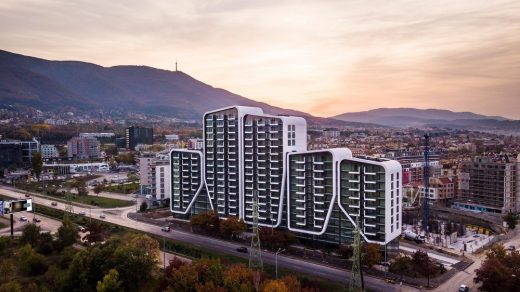
photograph : 3 in Spirit
A3 – Advanced Architecture Apartments in Sofia
Varna Office Building Design, Varna
Design: MMXX Architects
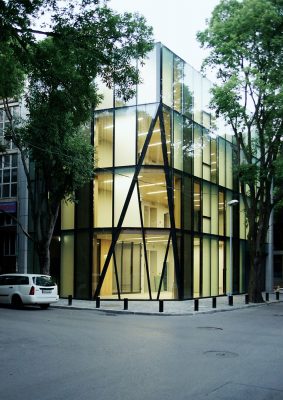
photo © Magdalena Matanova
Varna Office Building
Bulgarian Resort Development
Design: Foster + Partners
Sofia Multifunctional Complex
Design: Foster + Partners
Comments / photos for the New Danube Bridge – Vidin-Calafat Bridge Bulgaria Romania page welcome

